1 Introduction
In traditional tense logic, it was postulated that expressions are only implicitly evaluated with respect to times: logical variables could denote individuals, not times; and time dependency was enforced by way of implicit parameters. Against this tradition, Partee (1973) and a long line of researchers have argued that natural language has time-denoting variables – albeit ones that are usually invisible, and involve forms (such as tenses, or the word then) that look nothing like individual-denoting pronouns. Later research made use of situations rather than just times (e.g. Schwarz 2012; Kratzer 2019), and thus the key question became whether natural language has time/situation-denoting variables (as argued by Partee), or whether time/situation dependency is enforced by implicit parameters (as in tense logic). Situations are more fine-grained than times and thus what can be done with time variables can in principle be recoded in terms of situation-denoting variables.1 For terminological simplicity, we will talk about ‘temporal variables’ and ‘temporal pronouns’ without pre-judging whether these should be time- or situation-denoting.
Sign language research has provided overt evidence for the existence of temporal pronouns by showing that sometimes one and the same anaphoric form, involving pointing, has individual-denoting and temporal uses. Pointing towards loci (=positions in signing space) has been argued to be an overt realization of variables (e.g. Lillo-Martin and Klima 1990; Schlenker 2011; but see Kuhn 2016). Combined with this hypothesis, instances of temporal pointing provide evidence for the existence of temporal variables.2 In ASL (American Sign Language), the pointing sign and its variants (the dual, trial and plural pronouns) can refer to individuals and times/situations alike: in (1), one antecedent proposition is signed in locus a, and pointing towards that locus (glossed as ix-a) realizes an anaphoric form that means then (Schlenker 2013; acceptability appears as a superscript on a 7-point scale, with 7 = best; we boldface temporal pronouns).3
| (1) | Context: Every week I play in a lottery. | |
| re___ | ||
| 7 IX-1 a[SOMETIMES WIN]. IX-1 b[SOMETIMES LOSE]. | IX-a IX-1 HAPPY. | |
| ‘Sometimes I win. Sometimes I lose. Then [= when I win] I am happy.’ (ASL, 7, 204) | ||
In ASL, a sagittal (=backward-forward) temporal line is used to situate certain lexical forms – e.g. the sign for tomorrow moves forward, while yesterday moves backwards, intuitively showing the temporal relation to the present moment (see Friedman 1975). But we know of no clear cases of pointing to loci on this timeline. In (1) and similar examples, pointing targets the normal signing space (i.e. the space in front of the signer, rather than on the sagittal timeline), just like nominal anaphora. In fact, the pronoun in (1) could conceivably be analyzed as nominal in nature, akin to adverbial uses of that time in English4: for lack of pointing towards the timeline, no data showed any morphological distinction between nominal and temporal pointing. Sinte (2013; 2015) and Engberg-Pedersen (1993) list up to six temporal lines across sign languages, but only tangentially discuss anaphoric pointing towards temporal loci (for this reason, we will not further discuss their findings here).
Investigating LIS (Italian Sign Language), Aristodemo (2017) discussed numerous cases of pointing towards a diagonal timeline anchored on the non-dominant arm in front the signer, with an order-preserving (‘iconic’) mapping (=later is further towards the dominant side). She also argued that there are important similarities between time-denoting pointing and degree-denoting pointing in comparatives and related constructions, and in fact she treated some temporal expressions as degree constructions.
Based on original work on CSL (Chinese Sign Language), we present two main findings. First, we replicate data from ASL involving temporal pointing in the normal signing space (in front of the signer). Second, going beyond extant results, we show that CSL allows for pointing on specifically temporal timelines, including on the ‘past’ part of the sagittal one. This leads to surprising cases in which the signer establishes a locus that is partly behind her on the sagittal timeline, and then has to slightly rotate her body in order to point towards it – something we haven’t seen described for other sign languages.
While these findings form the theoretical core of this article (and establish the reality of specifically temporal variables), we also contribute to the analysis of the temporal and anaphoric system of CSL, a highly understudied language within formal linguistics. We show that at least two timelines allow for pointing: besides the sagittal one, a vertical one does too, with past vs. future corresponding to up vs. down (a horizontal line involves additional complexities). We also show that overt temporal anaphora can be realized by a further mechanism involving ordered fingers. Finally, we note that several of our examples involve an overt reference point that may but need not be the time of utterance; in such cases, temporal reference involves two loci, and may be reminiscent of complex tenses such as the pluperfect in English.
2 Elicitation methods and transcription conventions
2.1 Elicitation methods
Elicitation was conducted using the ‘playback method’, described in Schlenker (2013; 2014) and Kuhn (2016). It involved repeated quantitative acceptability judgments (1–7, with 7 = best) by two consultants, henceforth Huan and Yingjie5; guidelines for assessment appear in SM II [=Supplementary Materials II]. In line with multiple articles using the same methods, judgments are reported as superscripted numbers before example sentences, in lieu of standard markers of grammaticality. Videos were assessed (4 times by each consultant) on different days, with at least a 2-day interval between consecutive exposures (ordering of the target sentences was varied). We only report aggregate averages over the two consultants’ judgments, unless there was at least a 3-point difference between their individual averages, in which case we report these individual averages separately (all judgments can be found in SM III [=Supplementary Materials III]). All new examples below include links to the original videos. Each sentence is followed by the reference of the relevant video (e.g. CSL IMG_0600), and a hyperlink to it; the videos can also be found (and identified by their reference) in a downloadable folder (see https://osf.io/yzq8v/).
2.2 Transcription conventions
Sign language sentences are glossed in capital letters, as is standard. Numbers are used to distinguish variants of a sign (e.g. drink1, drink2), and ++ and +++ are used for 2 and 3 iterations respectively. Loci in normal signing space are alphabetized in the temporal order in which they appear (i.e. a is first, b is second, etc.). expressioni (or iexpression in ASL transcriptions cited from earlier literature) indicates that a (possibly complex) expression is signed in locus i. ix-i (for ‘index’) is a pointing sign towards locus i; ix-1 and ix-2 indicate pointing to the signer and addressee respectively. When the CSL first person pronoun does not involve pointing, it is glossed as pro1. Plural pronouns are glossed as ix-arc in ASL, and as ix-plural in CSL. For brevity, when the beginning of a translation remains constant in a paradigm, we include it in full the first time, and then only use ‘…’; otherwise glosses appear in full, as they may include minor variations from one example to the next.
We refer to the three axes as ‘sagittal’ (=S), ‘vertical’ (=V) and ‘horizontal’ (=H), as illustrated in (2), with the time-to-space mapping given in (3); in (3), we add * if the relevant part of a line is unavailable to establish antecedents, and ? if it is only partly available, as we discuss below.
- (2)
- Timelines in CSL
- Solid lines indicate that a timeline is fully available to establish antecedents; absent timelines are not available to establish antecedents; dotted lines indicate that timelines are partly available (‘v-’ is available but primarily used by older signers, therefore we use bold dotted line to mark it).
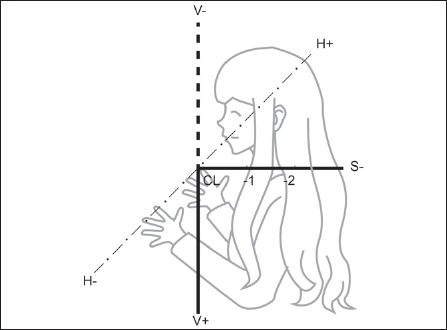
- (3)
- Time-to-space mappings for different lines
-
Line Abbreviation Past-denoting loci: –1, –2, –3… Future-denoting loci: +1, +2, +3… Sagittal s backward *forward Vertical v upward downward Horizontal h ?rightward or leftward ?rightward or leftward
We transcribe CSL temporal loci with a subscripted letter corresponding to the timeline used (s, v, or h) and integers encoding the relative order of loci on this timeline. We use 0 for the locus denoting the utterance time, negative indices for loci denoting past moments, and positive indices for future moments – e.g. pointing to the first past locus on the sagittal timeline is glossed as ixs-1, and pointing to the second future locus on the vertical timeline as ixv +2. For clarity, we boldface temporal anaphoric forms.
cl transcribes a temporal classifier that serves as a point of reference (‘reference time’), and which may appear at different loci on a timeline, e.g. as cl0 if it indexes the time of utterance. When two signs are produced simultaneously, as often happens with cl, we connect them with ^ (the sign produced by the non-dominant hand appears first). Thus cl0^ix0 transcribes the simultaneous production of cl0 with the non-dominant hand and ix0 with the dominant hand. Non-manuals are not transcribed unless cited from earlier literature, in which case re refers to raised eyebrows, and appears at the beginning of a line that shows the extent of eyebrow raising (as already seen in (1)).
3 Temporal loci in ASL and in LIS
Schlenker (2013) provided instances of temporal anaphora in normal signing space rather than on dedicated timelines. Examples involved not just normal pointing, as in (1), but also dual, trial and plural pointing, as in (4), assessed for acceptability on a 7-point scale. In each case, the loci are established in the first clause, and retrieved by an index meaning ‘then’/‘at those times’. (Plural indexing with two loci, as in (4)b, is slightly degraded.)
| (4) | Context: Every year, the speaker plays in the lottery. | |
| a. | 6.5 SOMETIMES IX-1 a[VERY LUCKY]. SOMETIMES b[LITTLE-BIT LUCKY]. | |
| re___________________________________ | ||
| NO-MATTER THE-TWO-a, b IX-1 HAPPY. | ||
| ‘Sometimes I am very lucky. Sometimes I am a little lucky. In both cases, I am happy.’ | ||
| b. | 5.8 SOMETIMES IX-1 a[VERY LUCKY]. SOMETIMES b[LITTLE-BIT LUCKY]. | |
| re_____________________________ | ||
| NO-MATTER IX-arc-a, b IX-1 HAPPY. | ||
| ‘Sometimes I am very lucky. Sometimes I am a little lucky. In these cases, I am happy.’ | ||
| c. | 6.5 SOMETIMES IX-1a[VERY LUCKY]. SOMETIMES b[MEDIUM LUCKY]. SOMETIMES | |
| re__________________________________________ | ||
| c[LITTLE-BIT cLUCKY]. NO-MATTER THE-THREE-a, b, c IX-1 HAPPY. | ||
| ‘Sometimes I am very lucky. Sometimes I am somewhat lucky. Sometimes I am a little lucky. In all three cases I am happy.’ | ||
| d. | 6.7 SOMETIMES IX-1a[VERY LUCKY]. SOMETIMES b[MEDIUM LUCKY]. SOMETIMES | |
| re______________________________________ | ||
| c[LITTLE- BIT cLUCKY]. NO-MATTER IX-arc-a, b, c IX-1 HAPPY. | ||
| ‘Sometimes I am very lucky. Sometimes I am somewhat lucky. Sometimes I am a little lucky. In these cases I am happy.’ (ASL, 7, 212; Schlenker 2013) | ||
Schlenker (2013) explicitly stated that the analysis could be developed in terms of time-denoting or in terms of situation-denoting variables, and argued in the end for a situation-based analysis due to a separate observation: temporal anaphora shares a crucial property with locative anaphora (as well as modal anaphora) in allowing for ‘Locative Shift’, a phenomenon whereby a locus associated with a place can be re-used later to refer to an individual that is located at that place (see also Schlenker 2018). Positing that locative, temporal and modal anaphora all involved reference to situations makes it easier to capture the existence of Locative Shift in all three cases: instead of association with a place, association with a situation was taken to drive Locative Shift. As we do not know of relevant facts pertaining to Locative Shift in CSL, this argument will not be replicated here, and we will correspondingly continue to remain agnostic about the optimal implementation of temporal anaphora (in terms of time- vs. situation-denoting variables).
Aristodemo (2017) and Aristodemo and Geraci (2018) describe two cases in LIS in which pronominal loci are iconically ordered along a line. First, discussing gradable adjectives, Aristodemo and Geraci (2018) argue that scalar degrees can be established as spatial loci on a vertical line and be retrieved by pointing pronouns, yielding overt degree anaphora. Second, Aristodemo (2017, Ch. 4) shows that analogous facts hold for temporal anaphora and the temporal adverbials before and after. In LIS, as in ASL, there is a sagittal temporal line used to situate some lexical items (past is back). The signs before and after share this basic form-to-meaning mapping, as seen in (5); but because the adverbs are signed on the non-dominant forearm, the timeline is skewed diagonally, possibly for phonetic reasons; as a result, the line is not purely sagittal but partly horizontal.
- (5)
- The signs before and after in LIS (Aristodemo 2017, Ch. 4)
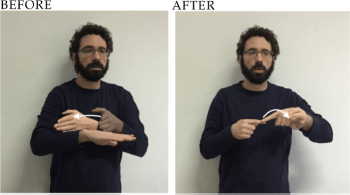
The signs before and after introduce temporal loci that can be retrieved by pointing to the relevant locus on the timeline, as is illustrated in (6).6
| (6) | BOSS STOCK SELL α-AFTER-β, PEOPLE WORK ALL STAMP BUY. IX-α IX-β DIFFERENCE ONE HOUR. |
| ‘All the workers bought the stamps [at the same time] after the boss sold the stocks. The difference between this time and that time is one hour.’ |
4 Temporal anaphora in normal signing space in CSL
We start by replicating our initial ASL examples in CSL: (7) and (8) display instances of singular and plural pointing respectively, paralleling (1) and (4). Here and throughout, we tested normal pointing with ix, as well as dual, trial and plural pointing, glossed respectively as the-two (=two moving back and forth between two loci), the-three (=three with a sweeping movement over the three loci), and ix-plural (=ix with an arc or sweeping movement over the relevant loci).7 All anaphoric forms were acceptable.
For our purposes, the key parts of (7) are the establishment of [lottery win]a in locus a on the signer’s right, then the establishment of [lottery fail]b in locus b on the signer’s left, and then use a pointing sign ix-a (towards locus a) to realize temporal anaphora to the cases in which the signer won. Pictures of key signs are enclosed in that example, left-aligned with the corresponding glosses (e.g. wina… appears above the picture of the sign win signed in locus a). The realization of target pronouns is circled in these pictures.
- (7)
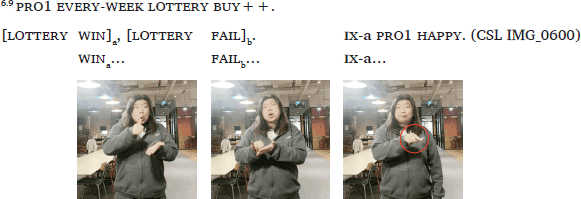
- https://youtu.be/nkW6kDZHNz4
- ‘Every week I buy a lottery ticketSometimes I win, sometimes I lose. In the first case, I am happy.’
The examples in (8) work in a similar fashion, but with three rather than two possible antecedents (in loci a, b and c), and with split antecedents for the dual, trial and plural pronouns.
| (8) | a. | 6 pro1 every-day lottery buy++. [lottery win big]a, [lottery five-yuan]b, [lottery cent no^have]c. the-twoa,b pro1 happy ix-c dislike. (CSL IMG_0601) https://youtu.be/6X-oXoN66KU |
| ‘Every day I buy a lottery ticket. sometimes I win big, sometimes I win five yuan, sometimes I get nothing. In the first two cases, I am happy; in the last case, I am not happy.’ | ||
| b. | 6.4 pro1.every-week lottery buy+. [lottery big]a, [lottery win five-yuan]b, [lottery cent no^have]c. the-threea,b,c all^three content. (CSL IMG_0602) https://youtu.be/GJDjX95wbuk | |
| ‘… In all these cases, I am content.’ | ||
| c. | 6.9 pro1 every-week lottery buy++. [lottery win big]a, [lottery five-yuan]b, [lottery cent no^have]c. ix-plurala,b,c pro1 content. (CSL IMG_0603) https://youtu.be/MHYJ98-paSE | |
| ‘… In all these cases, I am content.’ |
5 CSL timelines and reference time classifiers
In CSL, three timelines are attested by: (i) the realization of some lexical temporal elements; (ii) the establishment of temporal loci, and (iii) pointing towards these loci. The words past, yesterday, and recent are realized with backwards movement on the sagittal line, as illustrated in (9)a. On the vertical line, long-time-ago and early are realized with upwards movement, while later is realized with downwards movement, as illustrated in (9)b. We note that some of these temporal adverbs are anchored to the time of utterance (e.g. past) while others may be interpreted relative to another reference time (e.g. later).
- (9)
- PAST on the sagittal timeline, later on the vertical timeline.
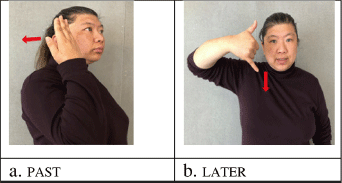
Lin and Gu (2020) find that different temporal domains are preferably mapped to different timelines: for past reference, the sagittal line is preferred (=backwards), while for future reference, the vertical line is preferred (=downwards). Use of the vertical line for past events (=upwards) is primarily found in older signers. Lin and Gu’s CSL data suggest that the horizontal line might not be intrinsically oriented: even for one and the same signer, the past is often realized towards the left but also sometimes towards the right. Therefore, we will not further consider the horizontal timeline, except to make points about the generality of certain constructions. We thus keep the horizontal line for future research, for two reasons: unlike the other lines, it is not intrinsically ordered; and there are several constraints on its use that we do not currently understand.
In many of our examples, movement relative to a reference time classifier is used to establish temporal antecedents. The time classifier cl may but need not denote the time of utterance (Lin and Gu 2020). In (10), the non-dominant hand establishes the reference time with cl while the dominant hand indicates a precedence relation (glossed as bef) along any of the three timelines. In (11), cl refers to a time other than the time of utterance, thus yielding a relative anteriority interpretation.
- (10)
- Temporal precedence expressed with cl on the three timelines
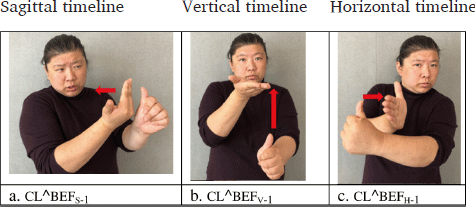
| (11) | 7 meet ix-a cls-1^s-1befs-2 pro1 marry-finish divorce.8 |
| ‘Before I met him, I had once married and divorced.’ (IMG_1801) https://youtu.be/rVVNUFjHtIM |
Notably, with bef, one and the same sign, denoting anteriority, can be used on any of the three timelines. Interestingly, as observed by Lin and Gu (2020), no analogously flexible “after” sign exists: all signs denoting a posteriority relation are lexically specified with respect to location and movement. For example, later in (9)b necessarily shows vertical movement.8
Finally, signs denoting days of the week may be ordered in space along the timelines, as shown in (12), where tuesday, wednesday, and thursday are arranged along the vertical one. Ordering days of the week in this way seems most felicitous along the future part of the horizontal timeline and the past part of the vertical timeline (see (16), (21)).
- (12)
- tuesday, wednesday, thursday ordered vertically
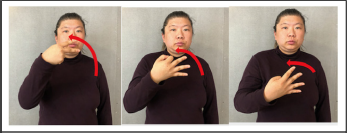
In sum, CSL offers three types of temporal antecedents along the timelines: a) the basic temporal signs, namely past, later, as in (9); the cl^bef construction, as in (10); c) week days, which can be ordered relative to each other on different timelines, as in (12) for the vertical case.9
6 Sagittal timeline
In this and the next section, we investigate the sagittal and the vertical timelines in turn, with examples involving lexical antecedents (e.g. past, week days) and non-lexical ones with compounds involving cl. Our contexts involve three time points so as to investigate standard, dual, trial and plural pointing. Importantly, we do not seek to explain why events may or may not be mapped to certain parts of certain timelines; we only seek to show that when this is possible, they can serve as antecedents for anaphoric pointing. In (13), the three temporal loci 0, s-1 and s-2 are established on the sagittal line. Since past-denoting indexes are located towards the back, the signer typically rotates her body slightly to avoid pointing over her shoulder.
| (13) | a. |  |
||
| (CSL IMG_0666; see also SM I) https://youtu.be/OA5PWIqNb0E | ||||
| ‘I now work as a university teacher; before that, I was a PhD student; before that, I worked in a hotel. Then (as a PhD student) and then (when I worked in a hotel) I drank. Now I do not drink.’ | ||||
| b. | 5.4 now pro1 work university teacher, 0pasts-1 read phd, s-1 pasts-2 hotel work, the-twos-1, s-2 drink1, ix0 drink1 not. (CSL IMG_0668) https://youtu.be/ldjPPEdlQhA | |||
| ‘… At those two times (as university teacher and as a PhD student) I drank. Then (when I worked in a hotel), I did not drink.’ | ||||
| c. | 6 now ix0 work university teacher, 0pasts-1 ix1 read phd, s-1pasts-2 ix2 hotel work, the-three0,s-1,s-2 drink2 have. (CSL IMG_0761) https://youtu.be/0XiHpVyou9w | |||
| ‘… At all three times, I have drunk.’ | ||||
| d. | 6.3 now ix0 work university teacher, 0pasts-1 ix1read phd, s-1pasts-2 hotel work ix2, ix-plural0,s-1, s-2 drink2 like. (CSL IMG_0760) https://youtu.be/uLn6JXP3xsg | |||
| ‘… At all these times, I liked drinking.’ | ||||
Though generally acceptable, (13)b is slightly degraded, possibly due to an ambiguity: both consultants noted that the form for the-two can also mean same in CSL. Similar judgments also appear for other uses of the dual pronoun (e.g. (14)b, (16)b, (17)b). In contrast, plural pointing remains the most acceptable form across examples (e.g (14)d, (16)d, (17)d). These subtle differences in acceptability of plural forms potentially have pragmatic or psychological origins; both consultants agreed that plural marking is easier than normal pointing to articulate and perceive, as the circle or sweeping movement does not require individuation of the different variables.
In (14) below, the classifier cl is at locus 0, denoting the present, while bef (co-articulated with cl) establishes a precedence relation by moving between loci 0 and s-1 and then between s-1 and s-2 on the sagittal axis (the degraded character of these sentences might be due to the context sentence rather than to temporal anaphora per se; see SM I).
- (14)
- a.
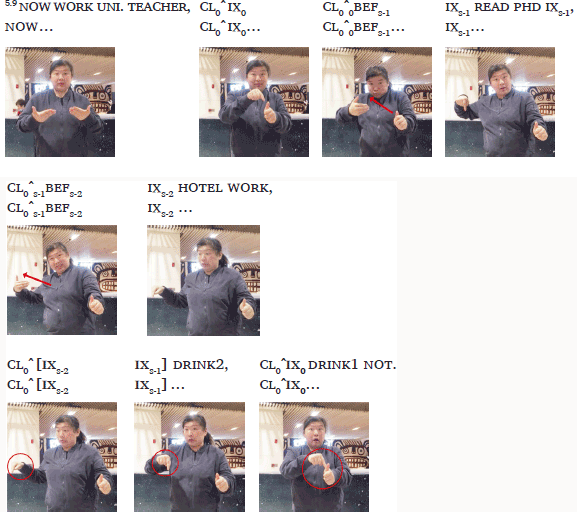
- (CSL IMG_0686; see also SM I) https://youtu.be/hCJJz----93_U8g
- ‘I now work as a university teacher; before that, I studied as a PhD student; before that, I worked in a hotel. Then (as a PhD student) and then (when I worked in a hotel) I drank. Now I do not drink.’
- b.
- 5.3 now work university teacher, cl0^0befs-1 read phd, cl0^s-1befs-2ixs-2 hotel work, cl0^ ix0 cl0^ the-two0,s-1 drink1, ix-s-2 drink1 not. (CSL IMG_0690) https://youtu.be/5JDB64PX9y8
- ‘… At those two times (as university teacher and as a PhD student) I drank. Then (when I worked in a hotel), I did not drink.’
- c.
- 5.8 now cl0^ ix0 work university teacher, cl0^0befs-1 ix1 read phd, cl0^s-1 befs-2 ixs-2 hotel work, cl0 ^ix0 the-three0,s-1,s-2 drink2 have. (CSL IMG_0762) https://youtu.be/IS8DqMjY5-A
- ‘… At all three times, I have drunk.’
- d.
- 6.8 now cl0^ ix0 work university teacher, cl0^0befs-1 ix1 read phd, s-1befs-2 ixs-2 hotel, ix-plural0, s-1,s-2 drink2 have. (CSL IMG_0763) https://youtu.be/nTI8Frjeqp0
- ‘… At all these times, I have drunk.’
In sum, all types of anaphoric pointing are thus acceptable on the ‘past’ part of the sagittal line.
7 Vertical timeline
In (15), the same three periods are described by establishing loci on a vertical timeline. In the first sentence, the classifier cl is again at locus 0, while bef establishes a precedence relation by moving on the vertical axis: first between 0 and v-1; then between v-1 and v-2 (or, sometimes, between 0 and v-2, with no discernible semantic difference). Temporal pointing is less acceptable than in analogous examples on the sagittal line, but this is likely due to the context sentence, which is degraded on its own (see SM I).
- (15)
- a.
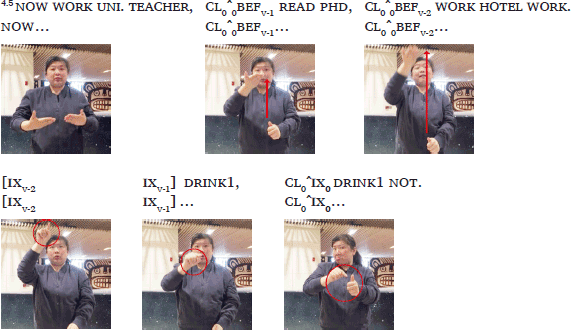
- (CSL IMG_0677; see also SM I)
- https://youtu.be/KQ-tvK-WR6w
- ‘I now work as a university teacher; before that, I was a PhD student; before that, I worked in a hotel. Then (as a PhD student) and then (when I worked in a hotel) I drank. Now I do not drink.’
- b.
- 3.3now work university teacher, cl0^0befv-1 read phd, cl0^v–1befv-2 hotel work, cl0^the-twov-2,v-1 drink1, cl0^ix0 drink1 not. (CSL IMG_0678) https://youtu.be/eCkWkHCFtks
- ‘… At those two times (as university teacher and as a PhD student) I drank. Then (when I worked in a hotel), I did not drink.’
- c.
- 4.4 now cl0^ix-0 work university teacher, cl0^0befv-1 ix-1 read phd, cl0^v–1befv-2 hotel ix-2, cl0^ ix-0 the-three0,v-1,v-2 like drink2. (CSL IMG_0765) https://youtu.be/9JKywcl3P8k
- ‘… At all three times, I liked to drink.’
- d.
- 5.4 now cl0^ ix-0 work university teacher, cl0^0befv-1 ix-1 read phd, cl0^v–1befv-2 work hotel, cl0^ ix-plural0, v-1, v-2 like drink2. (CSL IMG_0764) https://youtu.be/2S_WSG8icio
- ‘… At all these times, I liked to drink.’
When week days serve as antecedents, pointing is possible, as in (16), which involves dual and plural pointing: tuesdayv-3, wednesdayv-2 and thursdayv-1 are arranged vertically with the earliest day at the top and the last day at the bottom.
| (16) | a. | 7tuesdayv-3 work, wednesdayv-2 together drink, thursdayv-1 play-mahjong, ixv-3 pro1 so-so. (CSL IMG_0746)https://youtu.be/ZQmyeiQaomg |
| ‘On Tuesdays, I worked; on Wednesdays, I partied; on Thursdays, I played Mahjong; on Tuesdays, I felt so-so.’ | ||
| b. | 5.9tuesdayv-3 work, wednesdayv-2 drink-together, thursdayv-2 play-mahjong, the-two v-3,v-2 pro1 like, ixv-1 so-so.(CSL IMG_0741) https://youtu.be/OP5QqppU-uk | |
| ‘… Both Tuesdays and Wednesdays I enjoyed my life; on Thursday, I felt so-so.’ | ||
| c. | 7tuesdayv-3 work, wednesdayv-2 drink-together, thursdayv-1 play-mahjong, the-threev-3, v-2, v-1 pro1 like. (CSL IMG_0742) https://youtu.be/Reze_ispfrk | |
| ‘On Tuesdays, I worked; on Wednesdays, I partied; on Thursdays, I played Mahjong. All those days I had a good time.’ | ||
| d. | 7tuesdayv-3 work, wednesdayv-2 drink-together, thursdayv-1 play-mahjong, ix-pluralv-1, v-2, v-3 pro1 like. (CSL IMG_0744) https://youtu.be/odj4RqDN2fs | |
| ‘… All those days I had a good time.’ |
We only found one form to establish future antecedents in CSL, namely later. Although it is lexically specified to have vertical motion (and thus cannot be used on the sagittal timeline), the start and end points of the movement can be modified to connect temporal loci, just as for bef. In (17), later establishes a posteriority relation by moving between 0 and v+1, and then between v+1 and v+2. The resulting discourses with pointing pronouns were judged as somewhat more acceptable than examples with bef on the vertical axis, with judgments similar to those with bef on the sagittal axis.
| (17) | a. | 6.5 now hotel work, 0laterv+1 read phd, v+1laterv+2 university teacher work, ix0 ixv+1 drink1, ixv+2 drink1 not. (CSL IMG_0694) https://youtu.be/E5cCqlwKkuQ |
| ‘Now I work in hotel, later I will become a PhD student, and after that I will become a university teacher. Now and then [as a Phd student], I drink, then [as a university teacher], I won’t drink.’ | ||
| b. | 4.6 now hotel work, 0laterv+1 read phd, v+1laterv+2 work university teacher, ix0 the-two0,v+1 drink1, ixv+2 drink2 not. (CSLIMG_0699) https://youtu.be/mawggLPZLjY | |
| ‘… Both now and when I become a PhD student, I drink, then [as a university teacher], I won’t drink.’ | ||
| c. | 5.9 now hotel work, 0laterv+1 read phd, v+1laterv+2 hotel work, the-three0, v+1, v+2 drink2 like. (CSLIMG_0771) https://youtu.be/dj13XX1YsVw | |
| ‘… At all three time, I will enjoy drinking.’ | ||
| d. | 6.4 now hotel work, 0laterv+1 read phd, v+1laterv+2 read work university teacher, ix- plural0, v+1, v+2 drink2 like. (CSL IMG_0770) https://youtu.be/6b4ZeoVWE_4 | |
| ‘…At all these time, I will enjoy drinking.’ |
8 Ordered fingers
Besides timelines, one of our consultants can establish temporal anaphora using ordered fingers on a vertical plane, as illustrated in (18).
- (18)
- Ordered fingers: a. three^ixF5, three^F5befF4, three^ixF4 b. five^ixF2

The non-dominant hand signs a numeral (=three in (19), (20), five in (21)b), which serves as an anchor for pointing signs. The fingers can stand for any past, present or future moments as long as they are appropriately ordered: the thumb corresponds to the earliest time, the little finger to the latest time (Lin and Gu, to appear). Notationally, we gloss finger loci in order, from the thumb (F1) to the pinky (F5), as illustrated in (19) (past anaphora) and (20) (future anaphora). All examples are accepted (to various degrees) by Yingjie. They are rejected by Huan, but she does not accept the sentence even without pointing in the first place, which suggests that temporal anaphora per se is not the source of the problem (see SM I). Why the two main consultants have such different judgments is currently open.10
| (19) | a. | now work university teacher, three^ f5beff4 read phd three^f4beff3 three^ixf3 work hotel, ixf3 ixf4 drink, ixf5 drink not. [Huan=1.8, Yingjie=6.8] (CSL IMG_0725; see also SM I) https://youtu.be/LpRnP36E7G4 |
| ‘I now work as a university teacher; before (being a teacher), I was a PhD student; before (being a student), I worked in a hotel. Then (when I worked in a hotel) and then (as a PhD student) I drank. Now I do not drink.’ | ||
| b. | now work teacher three^ixf5, three^[f5beff4ixf4] read phd three^f4beff3 hotel work, the-twof3, f4 drink, ixf5 drink not. [Huan=2, Yingjie=7] (CSL IMG_0726)https://youtu.be/T1fPJPmzZ70 | |
| ‘…At those two times (when I worked in a hotel and as a PhD student) I drank. Now I do not drink.’ | ||
| c. | now work university teacher three^ixf5, three^f5beff4 read phd three^f4beff3 hotel work, ix-pluralf3,f4,f5, drink like [Huan=2.3, Yingjie=5.8] (CSL IMG_0788) https://youtu.be/ul0URRdzyj0 | |
| ‘…At all these times, I like drunk.’ |
| (20) | a. | pro1 now work hotel three^ixf3, three^[ f3aftf4 ixf4] read phd, three^[f4aftf5 ixf5] work university teacher, three^(ixf4, ixf5) drink1, ixf3 drink1 not. [Huan=1.8, Yingjie=6.8] (CSL IMG_0721; see also SM I) https://youtu.be/T15UU2Denag |
| ‘Now I work in hotel, I will become a PhD student, and after that I will become a university teacher. Then (as a PhD student) and then (as a university teacher) I will drink. I do not drink now.’ | ||
| b. | now pro1 work hotel three^ixf3,three^[ f3aftf4 ixf4] phd, three^ixf5 work teacher, three^the-twof4, f5 drink1, three^ixf3 drink1 not. [Huan=3.3, Yingjie=5.3] (CSL IMG_0722) https://youtu.be/EIEViR_3Ukw | |
| ‘… At those two times (as a PhD student and as a university teacher) I will drink. I do not drink now.’ | ||
| c. | now work hotel work three^ixf3,three^[f3aftf4 ixf4] read phd, three^[f4aft] work university teacher, three^ix-pluralf3,f4,f5 drink like. [Huan=2.0, Yingjie=5.8] (CSL IMG_0789) https://youtu.be/0Tj3mtjVSho | |
| ‘…At all these times, I will enjoy drinking.’ |
Importantly, with week days as antecedents, both consultants accept ordered fingers, as seen in (21).
- (21)
- Context: a signer is talking about her weekly routine in the past.11
- a.
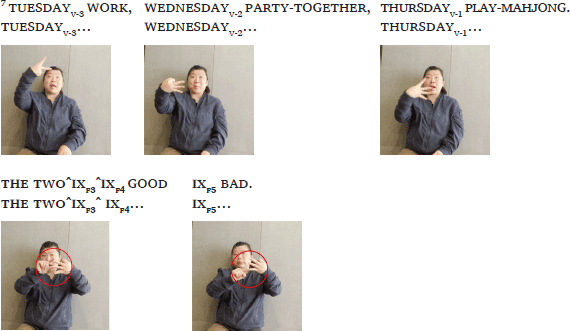
- ‘On Tuesday, I used to work, on Wednesday, I attended parties, on Thursday, I played Mahjong. On days on which I worked and I attended parties, I was happy; on days on which I played Mahjong, I was not happy. (CSL IMG_0749) https://youtu.be/H3mCXwIEPzk
- b.
- 6.5past pro1 money much. Tuesday five^ixf1play-mahjong, wednesday, five^ixf2play-poker, thursday five^ixf3 together-drink, friday five^ixf4 drive visit-around. five^ixf2lose^always. (CSL IMG_1501) https://youtu.be/6OMB8BzV_PQ
- ‘I was rich in the past, I played mahjong on Tuesdays, and played poker on Wednesdays, and went to parties on Thursdays, and drove outside to visit places on Fridays. Then (on Wednesdays) I always lost money.
In sum, ordered fingers can be used for temporal anaphora with week days for both consultants, but only one allows ordered fingers to stand for times more generally.11
Pointing to fingers is initially reminiscent of English ordinal adverbs: pointing at the thumb can be used like English first, and pointing at the pinky can be used like English finally. But unlike English adverbs, these fingers also establish temporal loci, which can be retrieved by pointing towards them later in the discourse. It should be added that pointing to fingers takes a slightly different form than pointing to spatial loci: the dual is formed by pinching together the two relevant fingers on the non-dominant hand; the plural is formed with a circular motion around all the fingers.12
9 Conclusion
Our results support earlier claims that sign language pronouns (including dual, trial and plural ones) can realize temporal anaphora, therefore adding to the evidence that natural language has time/situation-denoting variables – sometimes overt ones. But in one crucial respect we went beyond earlier analyses: these did not argue that sign language has specifically temporal variables used for anaphora; rather, an all-purpose device, namely pointing towards loci in normal signing space (in front of the signer), had nominal and temporal uses alike (in addition to locative and modal ones). By contrast, in CSL, locus establishment and pointing on the sagittal and vertical lines is a specifically temporal device.
Several important questions are left for future research. First, can these findings be extended to the horizontal timeline? Second, what semantic and grammatical differences are there between the various temporal devices studied in this piece? Third, why is the sagittal line preferred for past events and the vertical line for future events? More generally, how should the various constraints on the timelines be explained? Fourth, why do week days seem to make pointing easier? Fifth, how do examples with double-indexing involving CL relate to other mechanisms of temporal reference – and in particular to pluperfect forms, which have been analyzed with superficially similar devices (involving two variables) in von Stechow (2004) and Schlenker (1999; 2016)?13 Finally, can arguments be found for preferring a treatment in terms of time-denoting variables or one in terms of situation-denoting variables (a question we have remained agnostic about)?
Abbreviations
1 = first person 2 = second person, 3 = third person, pro = pronoun, CL = Classifier, ASL = American Sign Language, CSL = Chinese Sign Language, LIS = Italian Sign Language, bef = before, aft = after; h = horizontal; s = sagittal; v = vertical.
Notes
- More precisely: if situations are sufficiently finely individuated, (i) for every moment of time, there are multiple situations that exist at precisely that time (if we allow situation to exist at just one moment), and (ii) for every interval of time, there are multiple situations that exist precisely throughout that interval. [^]
- Two claims should be distinguished. The weaker claim is that language has the same kind of anaphoric mechanism (a pronominal one) for individual and for temporal reference. The stronger claim is that this joint anaphoric mechanism involves variables. Since ‘variable-free’ treatments can be given for pronouns, including in sign language (Jacobson 1999; Kuhn 2016; Schlenker 2016), the weaker claim doesn’t entail the stronger one. The stronger claim only follows if individual-denoting anaphora is implemented with variables. [^]
- In this transcription, re refers to ‘raised eyebrows’ over the temporal pronoun IX-a. [^]
- Even on this deflationary view, however, one must grant that the antecedent locus can be introduced by a non-nominal expression, since the first person ix-1 in (1) couldn’t possibly be responsible for the establishment of the locus a: it seems to be temporal in nature. [^]
- Both Huan and Yingjie were born deaf, are native signers of CSL, have no cochlear implant, and are active in the Shanghai Deaf community; they are also fluent in written Chinese. Huan comes from a hearing non-signing family, and was primarily educated in Shanghai Deaf schools (she also spent 3 years at the Singapore School for the Deaf, where she learned ASL and English). Yingjie comes from a signing Deaf family and went to Deaf schools in Shanghai. Yingjie appeared in all videos. Contexts appeared in written Mandarin; they were usually redundant with the beginning of the discourse signed on the video by Yingjie. [^]
- As in the case of degree anaphora, Aristodemo (2017) reports that the availability of these anaphoric forms depends on morphological factors. before and after both introduce temporal loci, but the word moment, despite having a superficially iconic form, indicating a period of time on the horizontal axis, cannot be used to introduce temporal loci. [^]
- We do not gloss the distinction between arc and sweeping versions of the plural pronoun; we do not know of semantic consequences of this distinction. [^]
- In this example, CL can be dropped on the sagittal and on the vertical line but not on the horizontal line. [^]
- There are additional constraints we do not get into here, pertaining to ease of articulation and visibility. For example, one might expect that clh-1^ h-1befh-2 can be used to establish anteriority of locus h-2 relative to locus h-1 on the horizontal timeline. But for a right-handed signer using a ‘before is to the left’ mapping, this would involve moving the right hand to the left of the left hand, hence a crossing that might be dispreferred in natural sign language production. [^]
- Eight months after the initial task, when we asked the consultants to rate the ordered fingers again, Huan’s ratings increased: she rated each of (19)a–c as 4 and each of (20)a–c as 5; Yingjie’s judgment remained consistent with her previous assessment. As we asked Huan to comment on her rating, she mentioned that she rarely saw such forms in real life, but on second thought, ‘they are understandable and natural’. [^]
- In this example, the week days are ordered along the vertical line, which then maps to the isomorphous fingers. [^]
- We leave it open at this point whether ordered fingers are used in the same way for non-temporal lists; more work is needed on that front. [^]
- A broader question is how modal anaphora works in CSL. Schlenker (2013) displayed similar devices for temporal and modal anaphora, but we only discussed the former in the present piece. [^]
Acknowledgements
Many thanks to our two CSL Deaf consultants: Yingjie Ni and Huan Sheng (Huan is also one of the authors). They gave us the right to make their videos and pictures publicly available. We are also grateful to Valentina Aristodemo and Charlotte Hauser for helpful references (Valentina Aristodemo also allowed us to reprint pictures from her dissertation). We are also very grateful to Glossa for a very efficient handling of this submission and for helpful reviewer comments.
Funding Information
Hao Lin: The present work was supported by the Ministry of Education in China (MOE) – Project of Humanities and Social Sciences (No. 20YJC740027) and supported by the Fundamental Research Funds for the Central Universities (No.2020114052).
Philippe Schlenker and Jeremy Kuhn: This research received funding from the European Research Council (ERC) under the European Union’s Horizon 2020 research and innovation programme (grant agreement No 788077, Orisem, PI: Schlenker). Research was conducted at DEC, Ecole Normale Supérieure – PSL University. DEC is supported by grant FrontCog ANR-17-EURE-0017.
Competing Interests
The authors have no competing interests to declare.
Author Contributions
Lin initiated the project and elicited the data. Schlenker provided the theoretical framework for analysis and discussion. Lin, Schlenker, Kuhn and Sheng devised the transcription conventions, analyzed the data and wrote the paper together. As a native Deaf signer, Sheng double-checked with Lin all the materials and proof-read the transcriptions of all the examples in the paper.
References
Aristodemo, Valentina. 2017. Gradable Constructions in Italian Sign Language. PhD dissertation, EHESS. DOI: http://doi.org/10.1007/s11049-017-9389-5
Aristodemo, Valentina & Geraci, Carlo. 2018. Visible degrees in Italian Sign Language. Natural Language and Linguistic Theory 36. 685–699. DOI: http://doi.org/10.1007/s11049-017-9389-5
Engberg-Pedersen, Elisabeth. 1993. Space in Danish Sign Language: the semantics and morphosyntax of the use of space in a visual language. Hamburg: Signum-Verlag.
Friedman, Lynn A. 1975. Space, time, and person reference in American Sign Language. Language 51(4). 940–961. DOI: http://doi.org/10.2307/412702
Jacobson, Pauline. 1999. Towards a variable free semantics. Linguistics and Philosophy 22. 117–184. DOI: http://doi.org/10.1023/A:1005464228727
Kratzer, Angelika. 2019. Situations in Natural Language Semantics. Stanford Encyclopedia of Philosophy. https://plato.stanford.edu/entries/situations-semantics/
Kuhn, Jeremy. 2016. ASL Loci: Variables or Features? Journal of Semantics 33(3). 449–491. DOI: http://doi.org/10.1093/jos/ffv005
Lillo-Martin, Diane & Klima, Edward S. 1990. Pointing out Differences: ASL Pronouns in Syntactic Theory. Fischer, Susan & Siple, Patricia (eds.), Theoretical Issues in Sign Language Research, Volume 1: Linguistics, 191–210. Chicago: University of Chicago Press.
Lin, Hao & Gu, Yan. 2020. Back to the Past and Down to the Future: Temporal Expressions in Chinese Sign Language Based on Naturalistic Data. Manuscript, Shanghai International Studies University and University College London.
Lin, Hao & Gu, Yan. to appear. ‘Hold Infinity in the Palm of your Hand’- a functional Description of Time expression through Fingers Based on the Naturalistic Data of CSL. Language and Cognition.
Partee, Barbara. 1973. Some structural analogies between tenses and pronouns in English. The Journal of Philosophy 70. 601–609. DOI: http://doi.org/10.2307/2025024
Schlenker, Philippe. 1999. Propositional Attitudes and Indexicality (A Cross-Linguistic Approach). MIT: PhD dissertation.
Schlenker, Philippe. 2011. Donkey Anaphora: the View from Sign Language (ASL and LSF). Linguistics and Philosophy 34(4). 341–395. DOI: http://doi.org/10.1007/s10988-011-9098-1
Schlenker, Philippe. 2013. Temporal and Modal Anaphora in Sign Language (ASL). Natural Language and Linguistic Theory 31(1). 207–234. DOI: http://doi.org/10.1007/s11049-012-9181-5
Schlenker, Philippe. 2014. Iconic Features. Natural Language Semantics 22(4). 299–356. DOI: http://doi.org/10.1007/s11050-014-9106-4
Schlenker, Philippe. 2016. Featural Variables. Natural Language and Linguistic Theory. 34(3). 1067–1088. DOI: http://doi.org/10.1007/s11049-015-9323-7
Schlenker, Philippe. 2018. Locative Shift. Glossa: a journal of general linguistics 3(1) 1–46. DOI: DOI: http://doi.org/10.5334/gjgl.561
Schwarz, Florian. 2012. Situation Pronouns in Determiner Phrases. Natural Language Semantics 20(4). 431–475. DOI: http://doi.org/10.1007/s11050-012-9086-1
Sinte, Aurélie. 2013. Expression of time in French Belgian Sign Language (LSFB). In Meurant, Laurence & Sinte, Aurélie & Van Herreweghe, Mieke & Vermeerbergen, Myriam (eds.), Sign language research, uses and practices: crossing views on theoretical and applied sign language linguistics, 205–236. De Gruyter Mouton. DOI: http://doi.org/10.1515/9781614511472.205
Sinte, Aurélie. 2015. Le temps en langue des signes. Presses Universitaires de Namur.
von Stechow, Arnim. 2004. Binding by Verbs: Tense, Person and Mood under Attitudes. In Lohnstein Horst & Susanne Trissler (eds.), The Syntax and Semantics of the Left Periphery, 431–488. Berlin; New York: Mouton de Gruyter.
